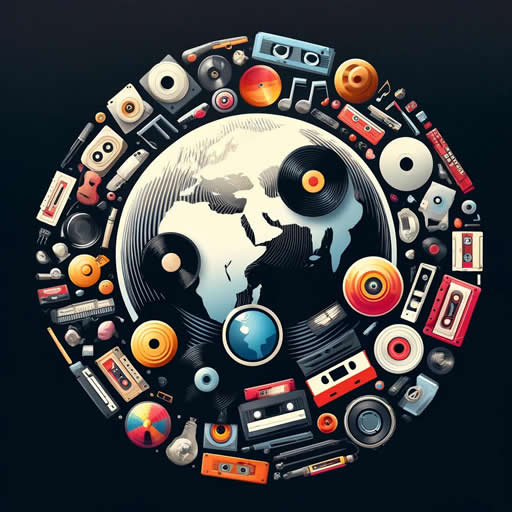The History of Vinyl Records: From Shellac to Digital
Key Takeaways
– Vinyl records have evolved from shellac discs in the late 19th century to today’s digital era, drastically transforming music production and consumption.
– The golden age of vinyl in the 1950s and 1960s solidified its place in music history, making it a cherished collector’s item today.
Introduction
Vinyl records, often considered the heart and soul of music memorabilia, have played a pivotal role in shaping the way we experience music. From the crackling shellac records of the late 1800s to today’s resurgence in digital landscapes, vinyl has undergone significant transformations. This article will immerse you in the fascinating journey of vinyl records, exploring how they have influenced music production and consumption across decades.
The Early Days of Vinyl Records
In the twilight of the 19th century, the world witnessed the birth of recorded music. The arrival of the phonograph in 1877 by Thomas Edison marked the dawn of a new era. Initially using cylindrical forms, the world of music recording was in its nascent stages. However, it was Emile Berliner’s invention of the flat disc record in the late 1880s that set the stage for the evolution of vinyl records as we know them.
The Advent of Shellac Records
Shellac records, predominantly used in the early 20th century, were made from a brittle material that left much to be desired in terms of durability and sound quality. Despite these limitations, shellac records were the mainstay format until the late 1940s. In these formative years, the records typically spun at 78 revolutions per minute, thus their nickname—78s.
Transition to Vinyl
The shift from shellac to polyvinyl chloride—a far superior and versatile material—came in the late 1940s. This transition not only improved sound fidelity and record longevity but also heralded the era of the 33⅓ and 45 RPM formats.
Related
– For a deeper dive into the historical transition from shellac to vinyl, explore The Evolution of Vinyl Record Pressing.
The Golden Age of Vinyl
The 1950s and 1960s are often celebrated as the golden age of vinyl. This period saw an explosion in music production and consumption, ingraining vinyl into the cultural fabric of society.
Revolutionizing Music Consumption
The introduction of Long Play (LP) records, capable of holding over 20 minutes per side, allowed for entire albums to be enjoyed without interruption. This innovation transformed the musical landscape, enabling artists to craft stories and concepts across longer formats. Genres like rock, jazz, and folk thrived during this transformative time.
Technological and Artistic Innovations
During this age, record players became key household items, and radio airwaves echoed with hits pressed into vinyl grooves. The rise of iconic record labels like Motown and Capitol Records showcased the potential for artistic expression. Meanwhile, cover art on album sleeves became an art form, adding a visual dimension to the auditory experience.
Vinyl’s Cultural Impact
Vinyl records did not just change how people listened to music—they also influenced fashion, politics, and culture. The counterculture movements of the 60s often found their voice echoing through the warm, analog tones of well-loved records. Artists like The Beatles, The Rolling Stones, and Bob Dylan left indelible marks on music history through their innovative use of the medium.
Related
– Discover the intricate connections between different vinyl genres at Exploring Vinyl Record Genres: From Jazz to Hip-Hop.
Modern Vinyl Records
The advent of digital technology threatened vinyl’s place in the music industry, yet it is now clear that vinyl’s appeal is enduring. The modern resurgence of vinyl records speaks to their timeless allure.
Digital Age Meets Analog Charm
In a world dominated by streaming services and digital downloads, vinyl records offer a unique, tactile interaction with music. The ritual of selecting a record, placing it on the turntable, and hearing the needle drop is an experience many find unmatched by digital platforms.
Collectibility and Resurgence
Vinyl has experienced a renaissance, emerging as collectibles and seen not only as sound storage but also as art pieces. Independent labels and artists are increasingly opting to release new albums on vinyl, even amidst the convenience of digital formats.
Related
– To explore the future trends of vinyl, visit The Future of Vinyl Records: Trends to Watch.
Sustainability and Legacy
While environmental concerns persist with the production of vinyl records, efforts are being made to create sustainable methods. Vinyl remains a symbol of music history and culture, uniting generations through its analog warmth and artistic presence.
Editor’s Picks
- Delve into the impact of electronic music on modern sound at How Electronic Music Shaped Modern Sound: A Collector’s Guide.
- Gain insights on maintaining your vinyl collection with The Best Way to Clean Vinyl Records.
- Explore the intricacies of vinyl trends and sales in Vinyl Sales and Popular Genres.
In conclusion, vinyl records have not only withstood the test of time but remain a cherished part of music history and culture. Their journey from the rudimentary shellac to today’s cherished collectible is a testament to their enduring appeal. As we embrace the future, the nostalgic charm of vinyl records continues to inspire and captivate music lovers worldwide.
